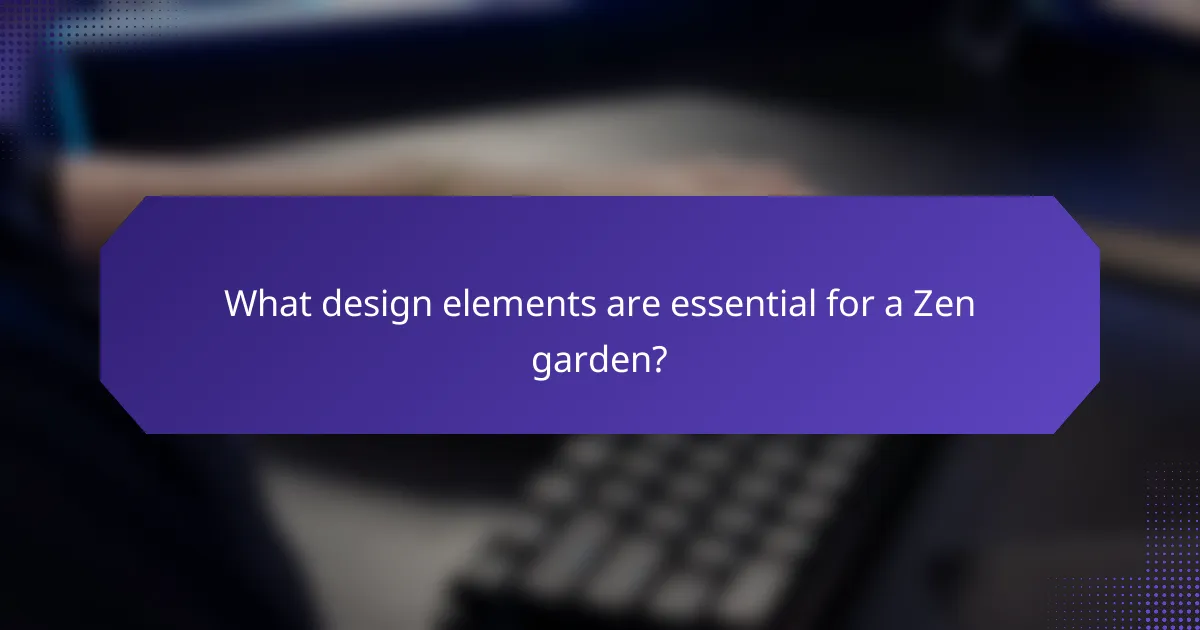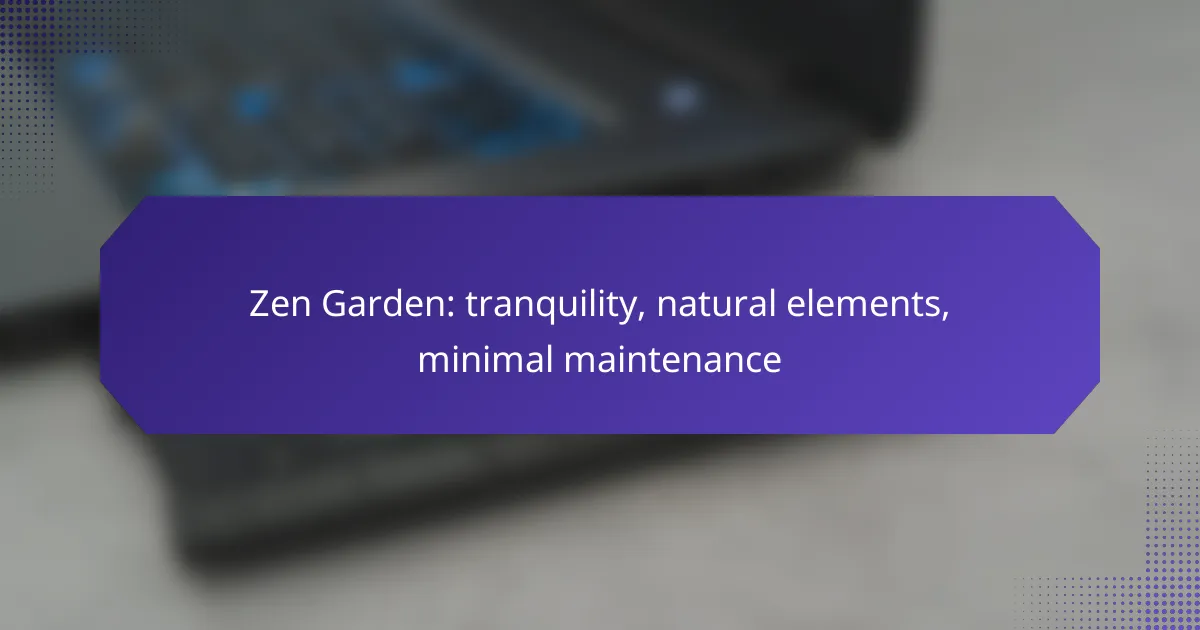A Zen garden is a serene space designed to promote tranquility through the careful selection of natural elements and minimal maintenance. By incorporating features that enhance outdoor aesthetics and encourage reflection, these gardens provide a peaceful retreat that harmonizes with the surrounding environment. In Canada, choosing the right plants can further elevate the calming atmosphere, ensuring your garden remains inviting throughout the seasons.

How to create a Zen garden in Canada?
Creating a Zen garden in Canada involves selecting the right location, using natural materials, and incorporating elements that promote tranquility. Focus on minimal maintenance to ensure your garden remains serene and inviting throughout the seasons.
Choose a suitable location
Selecting the right location is crucial for your Zen garden. Look for a quiet area that receives adequate sunlight and is sheltered from harsh winds. Ideally, the space should be easily accessible yet secluded enough to foster a sense of peace.
Consider the surrounding landscape and how it complements your garden. Proximity to trees or other natural elements can enhance the overall tranquility, while avoiding areas with heavy foot traffic will help maintain a serene atmosphere.
Select natural materials
Using natural materials is essential for creating an authentic Zen garden. Opt for local stones, gravel, and sand that reflect the natural landscape of Canada. These materials not only blend seamlessly with the environment but also require minimal maintenance.
When choosing wood for pathways or borders, select untreated cedar or other durable options that withstand the Canadian climate. This approach ensures longevity while maintaining the garden’s aesthetic appeal.
Incorporate water features
Water features can significantly enhance the tranquility of your Zen garden. Consider adding a small pond, a fountain, or a simple water basin to create soothing sounds and reflections. These elements invite wildlife and contribute to the garden’s serene atmosphere.
Ensure that any water feature is designed for easy maintenance. A small, recirculating fountain may be ideal, as it requires less upkeep while still providing the calming effects of water.
Design with minimalism in mind
Minimalism is key in Zen garden design. Focus on a few essential elements rather than overcrowding the space. Use simple lines and shapes to create pathways and borders, allowing for open areas that encourage contemplation.
Incorporate features like raked gravel or sand to symbolize water, and limit plant selections to a few carefully chosen species. This approach not only simplifies maintenance but also enhances the overall sense of tranquility.
Maintain low-maintenance plants
Choosing low-maintenance plants is vital for a sustainable Zen garden. Select native species that thrive in the Canadian climate, such as sedums, ferns, or ornamental grasses. These plants require less water and care, allowing you to focus on enjoying your garden.
Group plants based on their water and sunlight needs to simplify care. Regularly check for weeds and dead foliage to keep the garden looking pristine without extensive effort.

What are the benefits of a Zen garden?
A Zen garden offers numerous benefits, including promoting tranquility, enhancing outdoor aesthetics, and encouraging wildlife. These gardens require minimal maintenance while providing a serene space for reflection and relaxation.
Promotes relaxation and mindfulness
Zen gardens are designed to create a peaceful environment that fosters relaxation and mindfulness. The simplicity of the layout, often featuring sand, rocks, and minimal plant life, allows individuals to focus on the present moment.
Engaging with a Zen garden can involve activities like raking patterns in the sand or simply sitting quietly. These practices can help reduce stress and improve mental clarity, making them effective for meditation or contemplation.
Enhances outdoor aesthetics
A Zen garden enhances the visual appeal of outdoor spaces through its minimalist design and natural elements. The careful arrangement of stones, gravel, and plants creates a harmonious landscape that can complement various architectural styles.
Incorporating a Zen garden can increase property value, as many homeowners appreciate the beauty and tranquility these spaces offer. Simple features like a stone lantern or a small water element can further elevate the aesthetic experience.
Encourages wildlife and biodiversity
Zen gardens can attract various forms of wildlife, contributing to local biodiversity. By incorporating native plants and creating habitats, these gardens can support birds, butterflies, and beneficial insects.
Consider adding features like small ponds or rock piles to encourage wildlife visits. This not only enriches the garden’s ecosystem but also provides opportunities for observation and connection with nature.

What plants are best for a Zen garden in Canada?
In Canada, the best plants for a Zen garden are those that thrive in the local climate while embodying tranquility and simplicity. Consider species that require minimal maintenance and contribute to a serene atmosphere, such as Japanese maples, hostas, and ornamental grasses.
Japanese maple
Japanese maples are a popular choice for Zen gardens due to their graceful form and vibrant foliage. These trees can grow anywhere from 1 to 25 feet tall, depending on the variety, making them suitable for various garden sizes.
When selecting a Japanese maple, look for cultivars that are hardy in your specific region of Canada, such as ‘Bloodgood’ or ‘Emperor 1’. They prefer partial shade and well-drained soil, which helps maintain their health and aesthetic appeal.
Hostas
Hostas are excellent for adding lush greenery to a Zen garden, especially in shaded areas. These perennial plants come in numerous varieties, showcasing a range of leaf colors and sizes, from small to large.
Choose hostas that are hardy in Canadian climates, such as ‘Sum and Substance’ or ‘Patriot’. They require minimal maintenance, thriving in moist, well-drained soil, and can be easily divided every few years to promote growth.
Ornamental grasses
Ornamental grasses bring texture and movement to a Zen garden, creating a calming effect as they sway in the breeze. Varieties like Miscanthus sinensis and Panicum virgatum are well-suited for Canadian gardens and can reach heights of 2 to 6 feet.
These grasses are drought-tolerant and require little maintenance, making them ideal for a low-effort Zen garden. Plant them in clusters for a more natural look, and consider their seasonal changes for added visual interest throughout the year.

How to maintain a Zen garden?
Maintaining a Zen garden involves simple, consistent practices that promote tranquility and harmony with nature. Key tasks include regular raking, weeding, seasonal pruning, and caring for any water features to ensure the garden remains serene and visually appealing.
Regular raking and weeding
Regular raking is essential for maintaining the clean lines and patterns characteristic of a Zen garden. Aim to rake the gravel or sand at least once a week to keep it free of debris and to refresh the design.
Weeding should be done as needed, ideally every few weeks, to prevent unwanted plants from disrupting the garden’s aesthetic. Focus on removing weeds by hand to avoid damaging the surrounding elements.
Seasonal pruning of plants
Seasonal pruning helps maintain the shape and health of plants in your Zen garden. Perform light pruning in early spring to encourage new growth and remove any dead or damaged branches.
In the fall, consider a more thorough pruning to prepare plants for winter. This practice not only keeps the garden tidy but also enhances the overall tranquility by ensuring that plants do not become overgrown.
Water feature upkeep
Water features, such as ponds or fountains, require regular maintenance to ensure they remain clean and functional. Check the water level weekly and top it off as necessary, especially during hot weather.
Clean any filters or pumps monthly to prevent algae buildup and ensure proper water circulation. If your feature includes fish or plants, monitor their health and adjust feeding and care accordingly to maintain balance in the ecosystem.

What design elements are essential for a Zen garden?
Essential design elements for a Zen garden include natural materials like rocks, gravel, and plants that promote tranquility and minimal maintenance. These components work together to create a serene environment that encourages reflection and mindfulness.
Rocks and gravel
Rocks and gravel are fundamental elements in a Zen garden, serving both aesthetic and functional purposes. They symbolize mountains and water, creating a visual representation of nature that enhances the garden’s tranquility.
When selecting rocks, consider their size and shape; larger boulders can serve as focal points, while smaller stones can create pathways or borders. Gravel, typically white or light-colored, is often used to represent water and should be raked into patterns to evoke a sense of calm.
To maintain the garden, regularly check for weeds and debris in the gravel. Avoid using colored gravel, as it can disrupt the natural feel of the space. A simple rule is to use natural materials that blend harmoniously with the surrounding environment.










